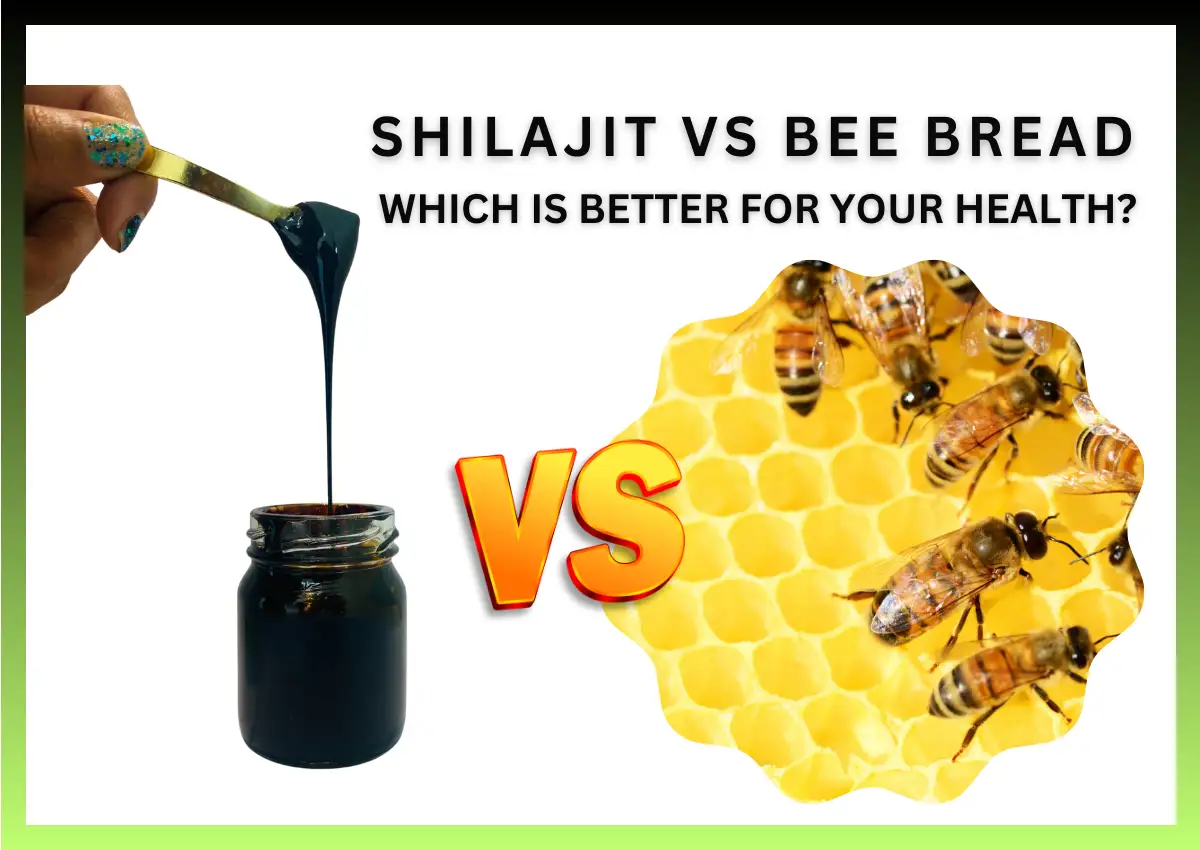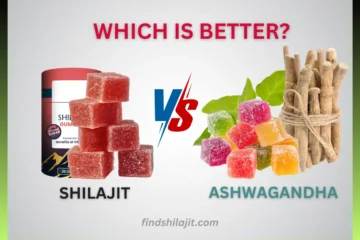In the world of natural superfoods, Shilajit and Bee Bread have both earned a loyal following for their impressive health-boosting potential.
Shilajit, a mineral-rich resin found high in the Himalayas and the Altai, has been prized in Ayurveda for centuries as a rejuvenating tonic.
Did You Know?
Authentic Shilajit can conduct electricity.
Bee bread—sometimes called perga—is a nutrient-dense fermented blend of pollen, honey, and enzymes made by bees, cherished in Eastern European and Russian folk medicine.
While both are marketed as natural energy enhancers and immunity boosters, they come from very different origins and have unique nutritional profiles.
This makes the Shilajit vs Bee Bread comparison especially interesting for anyone looking to choose the right supplement for their lifestyle.
In this post, we’ll break down what each superfood is, their key nutrients, and the science-backed health benefits, and ultimately help you decide which is better for your health — or whether you might benefit from taking both together.
What is Shilajit?
Imagine a rare, mineral-rich resin born from the slow alchemy of nature — plants, roots, and organic matter compressed within mountain crevices for hundreds of years, transformed by time, pressure, and the earth’s own microbiology.
This is Shilajit — not a herb, not a rock, but a biological-mineral concentrate that seeps from the high cliffs of the Himalayas, Altai, and Caucasus ranges when summer warmth softens the mountain ice.
Unlike ordinary supplements, Shilajit is a complex adaptogenic compound. It contains over 80 ionic trace minerals in a naturally bioavailable form, along with fulvic acid, a potent organic molecule that can pass through cell membranes, enhancing nutrient delivery deep into your tissues.
In traditional Ayurveda, Shilajit has been called “Destroyer of Weakness” — a name earned for its reputation in restoring energy, sharpening the mind, and supporting reproductive health.
Modern science now echoes this, with studies linking Shilajit to improved mitochondrial energy output, hormonal balance, and faster recovery from physical stress.
Recommended Dosage of Shilajit
- For Men: 300–500 mg of purified Shilajit resin or extract daily, ideally split into two doses (morning and early afternoon).
- For Women: 200–400 mg daily, in divided doses for steady absorption.
How to Take
Dissolve in lukewarm water or milk on an empty stomach. Always choose lab-tested, purified Shilajit to avoid contaminants and ensure safety.
Side Effects of Shilajit
- Heavy Metal Contamination Risk – Raw, unpurified Shilajit can contain lead, arsenic, or mercury; always use purified, lab-tested products.
- Allergic Reactions – Rare, but may include rash, dizziness, or increased heart rate in sensitive individuals.
- Lower Blood Pressure – Its vasodilating effect may not be suitable for those already on blood pressure medication.
- Iron Overload – Not recommended for people with hemochromatosis due to high iron content.
- Possible GI Discomfort – High doses may cause nausea, loose stools, or stomach upset.
What is Bee Bread?
Deep inside the beehive, beyond the golden honeycombs, lies a lesser-known treasure — Bee Bread, also called Perga.
Image Credit: Created with AI only for education
Unlike raw pollen that’s collected directly from flowers, Bee Bread is nature’s fermented superfood created by the bees themselves.
The process is remarkable: worker bees gather pollen, mix it with nectar or honey, and enrich it with their own enzymes.
This mixture is then packed into honeycomb cells, sealed with honey, and left to ferment naturally. Over time, this fermentation unlocks nutrients, breaks down hard-to-digest plant compounds, and produces beneficial probiotics—essentially turning pollen into a more bioavailable, nutrient-dense food.
Nutritionally, bee bread is a powerhouse:
- 20–25% high-quality protein containing all essential amino acids.
- A spectrum of vitamins (B-complex, K, E) and minerals like magnesium, potassium, and calcium.
- Rich in polyphenols and flavonoids with strong antioxidant activity.
- Naturally occurring probiotic bacteria to support gut health.
In traditional apitherapy, Bee Bread has been valued for boosting immunity, increasing stamina, and accelerating recovery after illness.
Modern studies suggest it may enhance athletic performance, improve digestive health, and reduce oxidative stress — making it a natural supplement for both vitality and longevity.
Recommended Dosage of Bee Bread
- Men & Women: 5–10 grams daily (about 1–2 teaspoons).
- Athletes or High Physical Demand: Up to 15 grams daily, split into two servings.
How to Take
Consume raw, mix into smoothies, yogurt, or oatmeal. Avoid heating above 40°C (104°F) to preserve enzymes and probiotics.
Side Effects of Bee Bread
- Allergic Reactions – High risk for individuals allergic to pollen, honey, or bee products; symptoms may include swelling, hives, or difficulty breathing.
- Digestive Discomfort – Overconsumption may lead to bloating, gas, or diarrhea due to its enzyme and probiotic content.
- Risk for Pregnant/Breastfeeding Women – Limited research; avoid unless approved by a healthcare provider.
- Potential Blood Pressure Effects – May slightly lower blood pressure in some people.
- Caloric Density – Though nutrient-rich, it is relatively calorie-dense and should be consumed in moderation for weight control.
Nutritional Profile Comparison: Shilajit vs Bee Bread
While both Shilajit and Bee Bread are considered nutrient-rich natural supplements, their nutritional strengths lie in very different areas. Here’s a side-by-side breakdown:
| Component | Shilajit | Bee Bread |
| Key Minerals | Contains over 80 ionic trace minerals, including iron, zinc, magnesium, and manganese — crucial for energy metabolism, oxygen transport, and cellular repair. | Rich in potassium, magnesium, phosphorus, and calcium, supporting heart function, muscle health, and bone density. |
| Bioactive Compounds | Fulvic acid, humic acid, and dibenzo-alpha-pyrones — known for enhancing nutrient absorption, reducing oxidative stress, and improving mitochondrial efficiency. | Polyphenols, flavonoids, and enzymes — powerful antioxidants and natural anti-inflammatory agents that also support digestion and immune function. |
| Protein Content | Minimal protein — Shilajit’s strength is in minerals and bioactive compounds, not macronutrients. | High-quality protein (~20–25%) containing all essential amino acids for muscle repair and tissue regeneration. |
| Vitamins | Minimal vitamin content; primarily a mineral source. | Vitamin-rich, especially B-complex (for energy), vitamin K (for bone health & clotting), and vitamin E (for skin & antioxidant protection). |
| Antioxidant Capacity | High — mainly due to fulvic acid and phenolic compounds that neutralize free radicals and protect cell structures. | High — thanks to polyphenols and plant-based antioxidants that combat inflammation and oxidative stress. |
Health Benefits of Shilajit
- Boosts Energy at the Cellular Level – Fulvic acid enhances nutrient transport into cells and supports mitochondrial ATP production, helping fight fatigue and improve stamina.
- Supports Male Hormonal Health—May naturally promote testosterone levels, sperm quality, and reproductive vitality, as shown in clinical studies.
- Enhances Nutrient Absorption – Acts as a natural nutrient carrier, increasing the bioavailability of vitamins and minerals from food and supplements.
- Improves Cognitive Function – Antioxidants protect brain cells from oxidative damage, while minerals support memory, focus, and mental clarity.
- Supports Recovery and Anti-Aging – Reduces inflammation and oxidative stress, aiding post-exercise recovery and slowing signs of aging.
- Promotes Healthy Blood and Oxygen Flow – Rich in iron and minerals to help maintain hemoglobin levels and improve oxygen delivery.
- May Support Immune System Function – Strengthens overall immune resilience through its mineral and antioxidant profile.
Health Benefits of Bee Bread
- Strengthens Immunity – Packed with polyphenols, flavonoids, and vitamins that help the body fight infections and maintain immune resilience.
- Supports Gut Health – Contains natural probiotics and enzymes that balance the gut microbiome and improve digestion.
- Enhances Physical Endurance – High-quality proteins and amino acids aid muscle repair, improve stamina, and speed up recovery.
- Promotes Cardiovascular Health – Rich in potassium and magnesium, which support healthy blood pressure and heart function.
- Provides Complete Nutrition – Delivers a balanced mix of proteins, carbohydrates, vitamins, and minerals in one natural food source.
- Reduces Inflammation – Plant-based antioxidants help combat chronic inflammation and oxidative stress.
- Supports Skin and Hair Health – Vitamin E and other antioxidants nourish skin cells and promote healthy hair growth.
Which is Better for Your Health? – Comparative Analysis
| Health Goal | Winner | Reason |
| Energy & Stamina | Shilajit | Fulvic acid improves mitochondrial ATP production, giving longer-lasting energy and reducing fatigue. |
| Hormonal Support (Men) | Shilajit | Shown in studies to support healthy testosterone levels and male reproductive function. |
| Immune Strength | Bee Bread | Rich in antioxidants, vitamins, and natural probiotics that strengthen immune defenses. |
| Gut Health | Bee Bread | Contains beneficial bacteria and enzymes that support digestion and microbiome balance. |
| Nutritional Completeness | Bee Bread | Offers proteins, vitamins, minerals, and carbs in a single whole food source. |
| Mineral Replenishment | Shilajit | Contains over 80 ionic trace minerals in highly bioavailable form. |
| Recovery After Exercise | Both | Shilajit reduces inflammation and supports tissue repair; Bee Bread provides amino acids and nutrients for faster recovery. |
| Long-Term Wellness | Combination | Shilajit for deep mineral and energy support, Bee Bread for complete daily nutrition and gut health. |
Can You Take Shilajit and Bee Bread Together?
Yes — you can take Shilajit and Bee Bread together, and their benefits may complement each other.
Shilajit’s fulvic acid and minerals enhance nutrient absorption, potentially improving the bioavailability of Bee Bread’s proteins, vitamins, and probiotics.
No clinical studies show harmful interactions, but choose pure, lab-tested products and follow recommended dosages to avoid overconsumption of minerals or allergens.
Also Read: Fadogia Agrestis vs Shilajit—Which Testo Booster Works?
How to Choose Quality Products
For Shilajit, choose lab-tested, purified resin with no fillers or additives.
For Bee Bread, look for cold-processed, organic, non-GMO sources to preserve nutrients.
Avoid supplements with unclear sourcing, artificial colors, or suspiciously low prices.
We recommend Wild Wood Apothecary’s Shilajit + Bee Pollen Synergism Capsules, trusted by hundreds of customers for purity, potency, and consistent energy support—backed by glowing reviews and third-party testing.
Conclusion
When it comes to Shilajit vs bee bread, there’s no single winner—it depends on your health priorities.
If you’re seeking mineral-rich energy, improved stamina, and enhanced nutrient absorption, Shilajit is your go-to, especially for active men and women looking to optimize performance.
On the other hand, Bee Bread shines for those wanting natural protein, probiotics, and a vitamin boost to support digestion, immunity, and overall vitality.
For many wellness enthusiasts, the real power lies in combining Shilajit and bee bread—unlocking the fulvic acid-driven absorption of Shilajit with the nutrient density of Bee Bread for a synergistic effect.
Whichever you choose, invest in pure, lab-tested products from trusted brands to ensure safety and potency. In the end, the best choice is the one that aligns with your body’s needs and your lifestyle goals.
Also Read: Moring vs Shilajit which one is the best?
FAQ
Is Bee Bread suitable for people with pollen allergies?
Bee Bread still contains bee pollen, so individuals with pollen or bee product allergies should avoid it or consult a healthcare provider before use.
Can Shilajit cause insomnia if taken at night?
Shilajit can increase energy levels, so some people prefer taking it in the morning to avoid potential sleep disruption.
How long does it take to feel the effects of Shilajit or Bee Bread?
Some users report increased energy and mental clarity within a few days, but optimal benefits may take 2–4 weeks of consistent use.
Which one is better for athletes—Shilajit or Bee Bread?
Shilajit supports endurance and recovery, while Bee Bread offers natural protein and antioxidants for muscle health. Both is best
References:
Bee Bread as a Promising Source of Bioactive Molecules and Functional Properties
Bee Bread: A Promising Source of Bioactive Compounds with Antioxidant Properties
Shilajit: A Natural Phytocomplex with Potential Procognitive Activity
Disclaimer
This article is for informational purposes only. Please consult a licensed healthcare provider before starting any new supplement, especially if you are pregnant, breastfeeding, or on medication.


